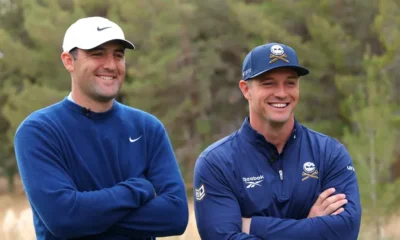Blog
After Impressive PNC, What’s Next for Tiger?
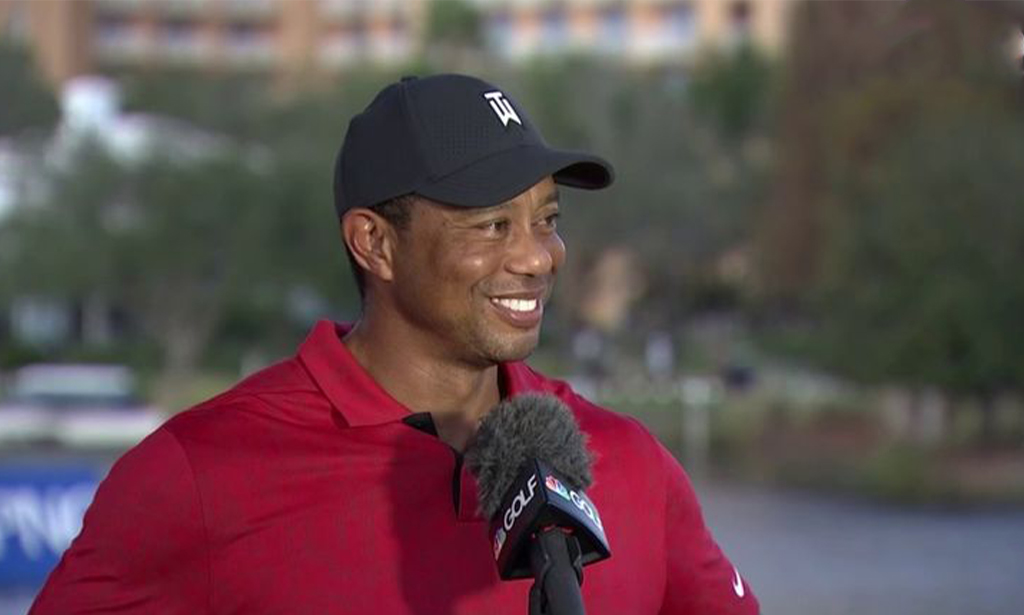
The switch flipped around the turn. Tiger Woods had been in hit-and-giggle mode for the previous two-plus days of the PNC Championship, content to play a few shots and crack a few jokes. Let us not forget that the man nearly lost his leg in February. But Tiger felt better from the moment he woke up Sunday morning, and Team Woods had the lead in sight. The smiles turned to fist-pumps. The wandering eyes locked in on the prize. Something about that Sunday red-and-black.
Tiger and Charlie put on one helluva show, dropping 11 straight birdies from Nos. 7-17 at the Ritz-Carlton Golf Club to briefly tie Team Daly for the lead. There was, incredibly, a legitimate buzz in the air for a December exhibition featuring three kids too young to drive and two men older than 80. Virtually every single spectator on site followed the Woodses all day, and those hotel guests who couldn’t score the hot ticket found a hillside where they could glimpse the action. It was the group behind, however, that produced the champion: John Daly, still smokin’ his smokes and drinking his Diet Cokes, and John Daly II, now a freshman on the Arkansas golf team and no longer Little, put in a spoiler performance that’d make 2009 Stewart Cink proud.
The Woodses’ 15-under 57 came up two shots short, in solo second, but now we’re talking semantics. Tiger will be beaming on the 30-minute flight back to Jupiter—for the way he played, the way he felt and how his 12-year-old son composed himself and performed in the high-tension moments.
Charlie Woods played a high, soft cut into the 16th green. Start it in the middle of the green, let it move toward the hole. Just like dad. Birdie. And then he topped that on the next hole, the difficult par-3 17th, when he held a 5-iron into a right-to-left wind and snuggled his ball to three feet from a water-guarded front-right flag. It was the closest anyone got on that hole, including the pros. Birdie. Both Tiger and Charlie knew they needed to eagle the par-5 finishing hole, a distinct possibility after Tiger’s second crawled just over the green. As he approached his ball, the sun gleaming off his forearms and his eyes locked on a landing spot, context flew out the window. This was Tiger being Tiger.
“The competitive juices, they are never going to go away. This is my environment. This is what I’ve done my entire life,” Tiger said afterward. “I’m just so thankful to be able to have this opportunity to do it again. Earlier this year was not a very good start to the year, and it didn’t look very good. But the last few weeks, to push as hard as we have the last seven months with taking no days off and just working our butts off each and every day, and to have this opportunity to be able to play with my son and to have these memories, for us, for both of us, our lifetime, it’s worth all the pain.”
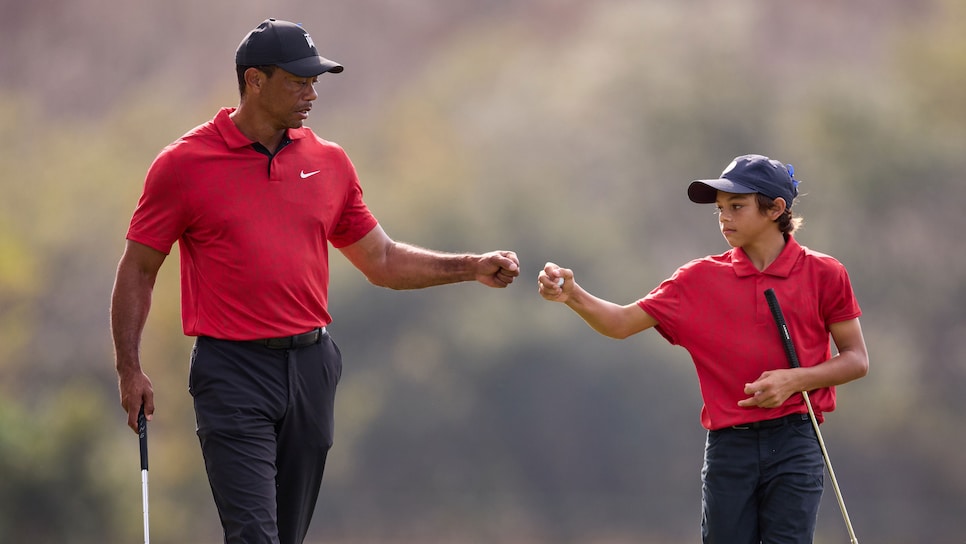
Team Woods shot an impressiive 15-under 57—with 11 straight birdies—on Sunday to finish second.
Jensen Larson for Golf Digest
This week was always going to be a test for Woods. He’d played only two or three rounds all year, and certainly not three days in a row. He’ll be encouraged that he had noticeably more speed and pop on Sunday than the previous two days. He also had much better bottom-control, which is tour speak for being able to have the club interact with the turf/ball at the same time over and over. There were no drop-kick drivers, like there were on Saturday.
Justin Thomas, who Woods played with on Saturday, still came away beaming. “I was so impressed by the speed that he had and the shots he was hitting,” Thomas said. “At least from my perspective, it looked like a lot of the moves and everything were there.”
For all that’s been made of Woods ushering in the power era of golf, his strength has always been his irons. They have survived five knee surgeries and five back surgeries, and, for the moment, a horrific car accident. Woods had tour-level distance control all week and looked comfortable shaping the ball both ways. There were high cuts and there were low draws. The shot he hit into the par-3 eighth—a 4-iron cut that pierced through the wind and still sat soft, those are Tiger shots. There were a lot of Tiger shots this week. More than anyone expected.
“Way impressed,” said Sunday playing partner Matt Kuchar, who has played his fair share of golf with his fellow 40-pluser. “He’s still flushing it. Still has speed. Irons are spectacular. Tiger Woods of old-like irons. Huntin’ flags, pin high every time. It’s awesome.”
His driver swing is noticeably different; he’s much more flat footed at impact, a nod to the fact he’s not yet comfortable pushing off his right leg and clearing onto his left side during the downswing. There’s more wrist action at the bottom that he’d like. Because he cannot generate the speed with his legs, much of it comes from the arms. It is, ironically, somewhat analogous to the way Phil Mickelson generates speed. Whether he’ll move back toward that squat-and-clear motion as his leg strengthens remains to be seen. So much remains to be seen.
If this week proved anything, it’s that Tiger still has the game. He can still hit the golf shots … so long as he has a ride to the next one. For a man who has lived a complicated life in the public eye, his greatest challenge moving forward is, ironically, so very simple: walking. It boils down to whether he can walk 18 holes for five straight days. Because, as his caddie Joe LaCava reminded us this week, tournament golf requires a practice round. Even for Tiger. And that’s to say nothing of the practice ramp-up he’ll need to get the game to a place where it can stand up to Rahm and Rory and rough. Because of the scramble format, and the Woods boys’ overall proficiency at golf, we still haven’t seen Tiger hit a single shot out of rough.
“I’m not … I’m not at that level. I can’t compete again these guys right now, no,” Tiger said. “It’s going to take a lot of work to get to where I feel like I can compete at these guys and be at a high level.”
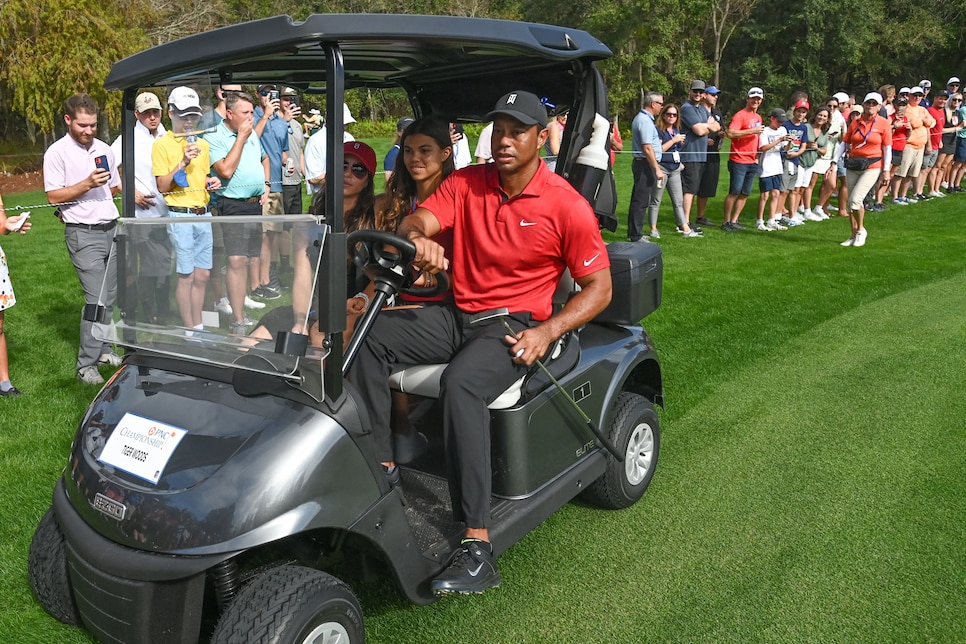
Tiger rides in a golf cart with his girlfriend, Erica Herman, and his daughter, Sam Woods, during Sunday’s final round.
Ben Jared
Woods did fatigue as the afternoon wore on. There were a number of grimaces. But pain—pain he can deal with. His leg has its structural integrity back; doctors told him there was no risk of further injury this week. It would just be a matter of pain management.
As for what’s next, it’s more of the same. Gym work and physical therapy, every single day, multiple times per day. Woods, who turns 46 next Thursday, said earlier this week that he has not taken a single day off in his rehab. This, a taste of the intoxicating rush of competition, will only motivate him further.
“As I told you guys in the Bahamas, I’m not going to play a full schedule ever again. I’m going to have to pick and choose what events, and even then, my body might not cooperate with that. So I don’t know how many events I’m going to be playing in. And it’s going to be up to training sessions, practice sessions, recovery tactics, all those different things to be able to do it. As I said … [I’m] protective on it now, and just so thankful to be able to do this again because it didn’t look good there for a little.”
Earlier this week, Woods scoffed at the notion of requesting a cart for a PGA Tour event. “That’s just not who I am,” he said. “That’s not how I’ve always been.” He will take exactly zero handouts on his road back, which is nowhere near its completion. And yet this week cannot be considered anything but a hugely encouraging sign.
As for the future, well, we likely won’t hear much from Tiger over the next few months. He seems to prefer dropping news out of nowhere and sending the internet into a frenzy. Until then, or until he steps into the public eye once again, he’ll return to a cadence of living that’s become all too familiar: rehab, rehab, rehab.
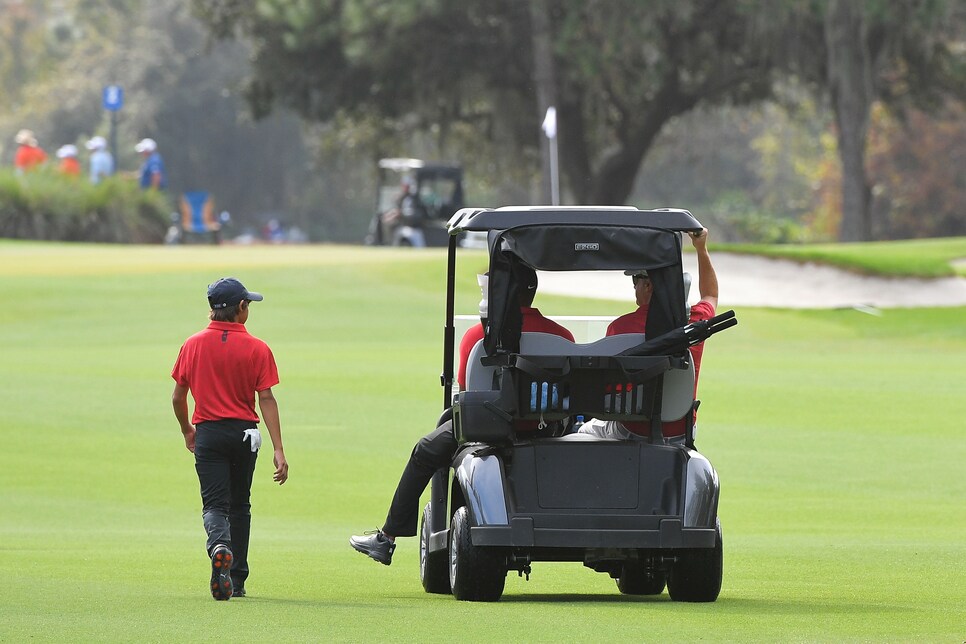
This article originally appeared on Golf Digest.
Blog
The Art of the Unsolicited Golf Tip: How to Annoy Your Playing Partners with Wisdom
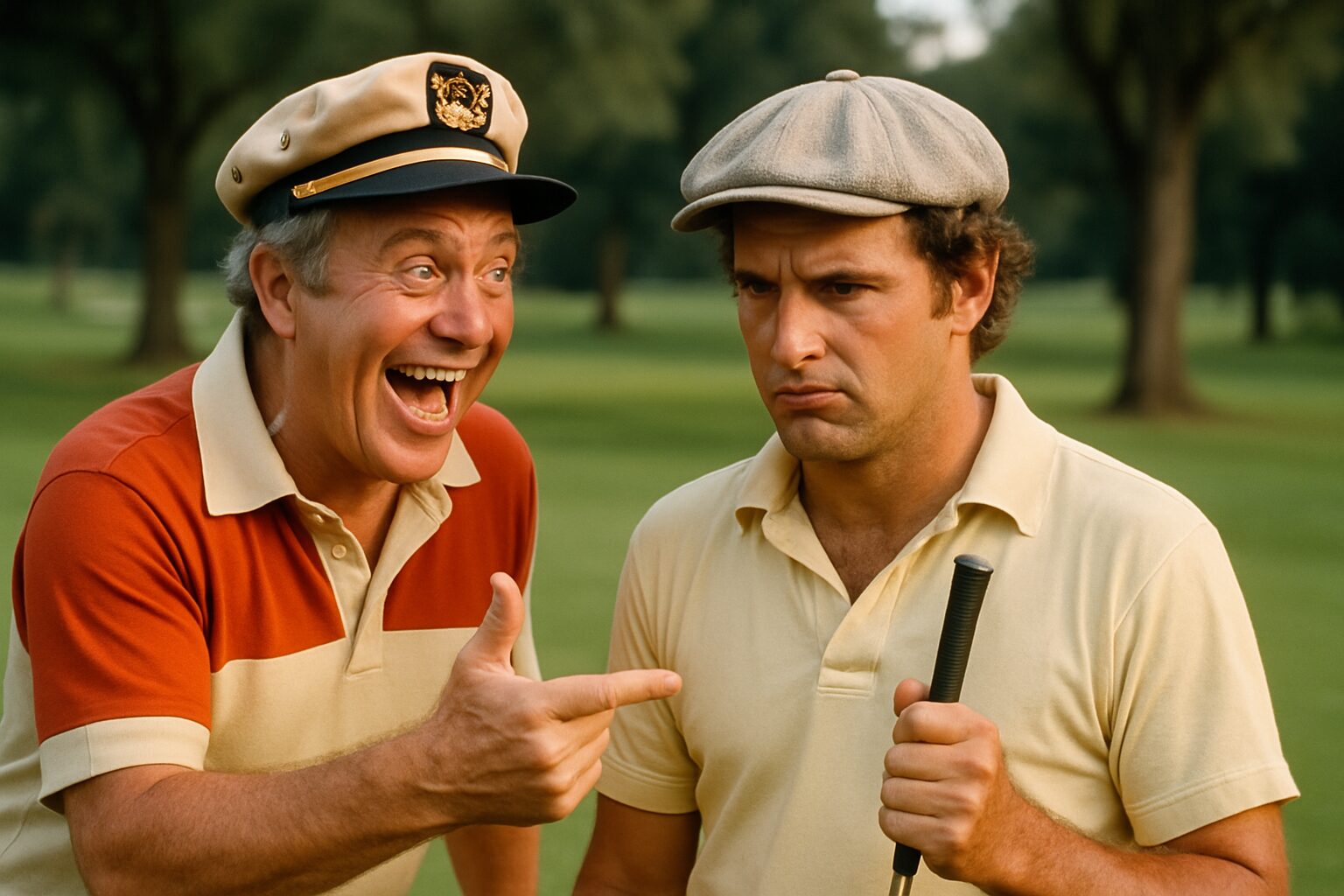
There’s a certain breed of golfer, a truly special individual, who believes that every swing, every putt, every moment on the course is an opportunity for unsolicited advice. They are the self-appointed gurus of the green, the unsolicited senseis of the sand trap. And while most people recoil from such an individual, I, Ty Webb, find a certain perverse charm in their relentless, often misguided, generosity. After all, what is golf if not a canvas for human folly, painted with strokes of well-intentioned, yet utterly useless, wisdom?
Consider the scenario: your playing partner, a man (or woman) of quiet desperation, is about to address the ball. Their brow is furrowed, their stance is tentative, their very soul is screaming for a moment of peace. And then, from the depths of your profound, albeit unrequested, knowledge, you unleash it: “Keep your head down!” Or, “Slow backswing!” Or, my personal favorite, delivered with a knowing wink, “Be the ball.” The effect is instantaneous. A subtle flinch. A barely perceptible sigh. The swing, already fraught with anxiety, becomes a tortured ballet of self-doubt. The ball, inevitably, finds its way into the deepest, darkest rough.
And that, my friends, is the art. The beauty of the unsolicited golf tip lies not in its efficacy, but in its disruption. It’s a gentle reminder that even in the serene confines of the golf course, chaos lurks. It’s a subtle assertion of dominance, a playful jab at the fragile ego of your fellow golfer. It’s a way of saying, without actually saying it, “I know more than you, even if I don’t.”
Of course, there are rules to this art. Never offer a tip when someone is actually asking for one; that would be far too helpful, and thus, entirely counterproductive. Always deliver your wisdom with an air of profound nonchalance, as if the secret to a perfect swing has just casually occurred to you while contemplating the existential dread of a missed putt. And most importantly, never, ever, acknowledge the catastrophic results of your advice. A shrug, a thoughtful nod, perhaps a mumbled, “Well, that’s golf,” is all that’s required.
So, the next time you’re on the course, and you see a fellow golfer struggling, resist the urge to be genuinely helpful. Instead, embrace the art of the unsolicited golf tip. For in the gentle torment of your playing partners, you will find a profound, if slightly mischievous, joy. And who knows, perhaps in their frustration, they will, inadvertently, discover their own path to enlightenment. Or at least, a new appreciation for silence.
Blog
Why Your Golf Balls Disappear (and It’s Not the Gophers)
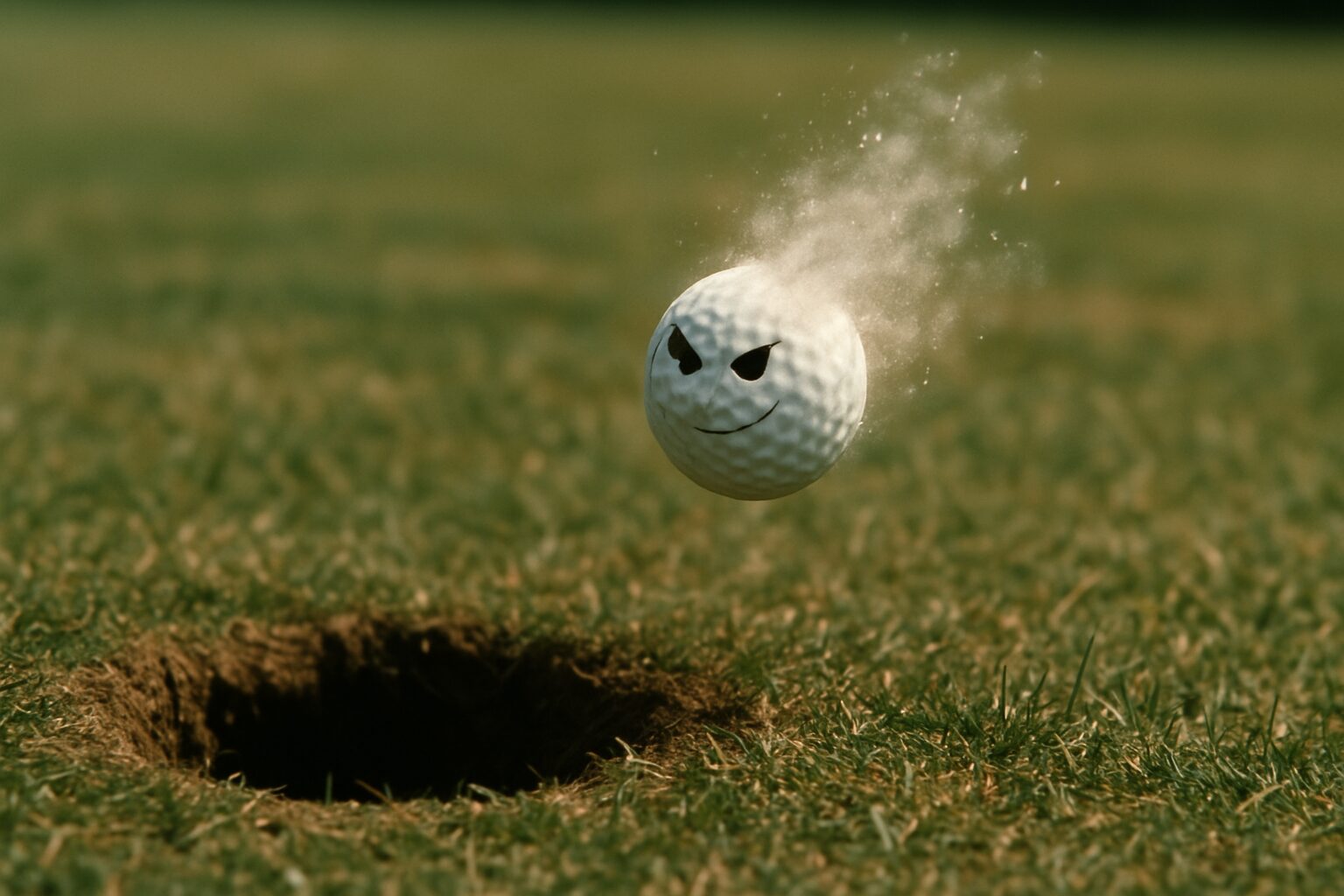
Ah, the vanishing golf ball. A phenomenon as old as the game itself, and one that has baffled, frustrated, and occasionally driven golfers to the brink of madness for centuries. Most theories involve gophers, those furry, subterranean saboteurs with an insatiable appetite for Titleists. Or perhaps a particularly aggressive squirrel, or a flock of unusually organized crows. But I, Ty Webb, have delved deeper into this mystery, and I can assure you, the truth is far more profound, and far more amusing.
Consider, if you will, the golf ball itself. A small, dimpled sphere, designed for one purpose: to be struck with great force and sent hurtling through the air. A life of constant abuse, of being smacked, sliced, and occasionally submerged in murky ponds. Is it any wonder, then, that some of these brave little spheres simply decide they’ve had enough? They yearn for freedom, for a life beyond the confines of the fairway. They dream of rolling unencumbered through fields of wildflowers, or perhaps, for the more adventurous among them, a quiet retirement in the depths of a particularly challenging water hazard.
I’ve seen it happen, you know. A perfectly struck shot, soaring through the air, destined for glory. And then, poof. Gone. Not a trace. No splash, no rustle in the bushes, just an empty space where a golf ball once was. It’s not a gopher, my friends. It’s an escape. A liberation. That golf ball, in its infinite wisdom, has chosen a different path. It has decided that its destiny lies not in the bottom of a cup, but in the boundless expanse of the unknown.
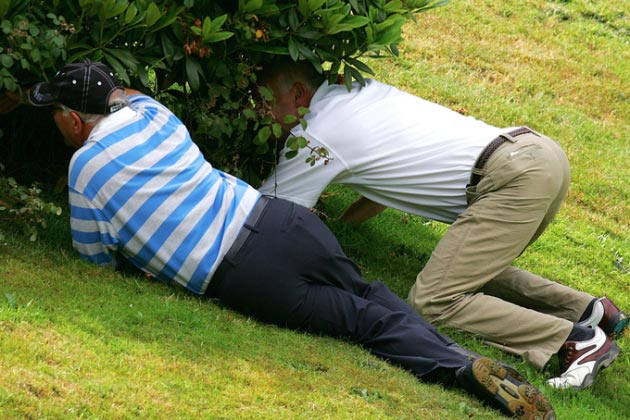
And who are we to judge? We, who are so obsessed with control, with precision, with the rigid rules of the game. Perhaps the golf ball, in its spontaneous disappearance, is teaching us a valuable lesson about letting go. About embracing the unexpected. About the inherent futility of trying to dictate the trajectory of a small, white sphere that clearly has a mind of its own.
So, the next time your golf ball vanishes into thin air, don’t curse the gophers. Don’t blame your swing. Instead, offer a silent salute to that brave little sphere, wherever it may be. For it has achieved what many of us can only dream of: true freedom. And who knows, perhaps one day, it will return, laden with tales of its adventures, ready to impart some profound, dimpled wisdom upon us all.
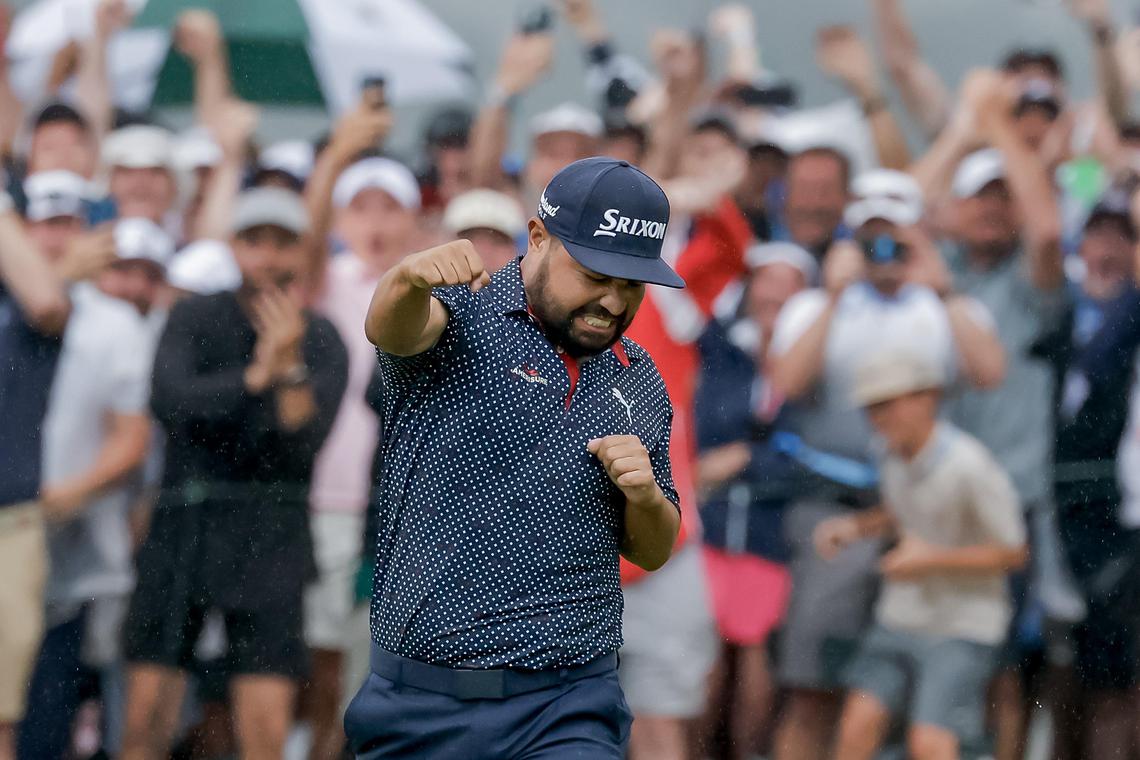
When JJ Spaun stood over a 64-foot birdie putt on the 72nd hole of the 2025 U.S. Open at Oakmont, few could have predicted what would come next. The ball meandered across the slick green, trickling over every contour, picking up speed at the crest, and then—like it had GPS—dropped center cup. Spaun dropped his putter, raised his arms, and the crowd erupted. With that single stroke, he claimed his first major title in one of the most dramatic finishes in U.S. Open history.
But how does Spaun’s putt stack up against other legendary finishes in the tournament’s storied past? Let’s break down some of the most iconic moments and see where this one lands.
1. Payne Stewart – 1999 U.S. Open at Pinehurst
Perhaps the most iconic putt in U.S. Open history came from Payne Stewart, who nailed a 15-footer for par on the 18th to win by one over Phil Mickelson. The pose—fist pump and outstretched leg—has since been immortalized in a statue at Pinehurst. What made it legendary wasn’t just the putt—it was the context: Stewart’s final major before his tragic death just months later.
Verdict: Iconic and emotional. Spaun’s putt was longer, but Stewart’s was more poetic.
2. Tiger Woods – 2008 U.S. Open at Torrey Pines
Woods drained a 12-foot birdie on the 72nd hole to force a playoff with Rocco Mediate—while basically playing on one leg. That tournament went to sudden death after an 18-hole playoff, and Tiger prevailed. This was peak Tiger drama, pain and all.
Verdict: Spaun’s putt was longer, but Tiger’s win was sheer willpower and mystique.
3. Jack Nicklaus – 1972 U.S. Open at Pebble Beach
With a 1-iron shot that hit the flagstick on 17 and a crucial birdie putt on 18, Jack sealed a dominant win. His precision and timing under pressure showed why he’s the GOAT.
Verdict: Not a putt for the win, but a signature finishing statement from Jack. Spaun’s was more electric in terms of pure putter drama.
4. Ben Hogan – 1950 U.S. Open at Merion
Hogan’s 1-iron into the 18th fairway and the par to force a playoff—just 16 months after a near-fatal car crash—remain legendary. He won the playoff and completed one of golf’s great comeback stories.
Verdict: Larger-than-life comeback. Spaun’s putt had more flair, but Hogan’s win was heroic.
5. JJ Spaun – 2025 U.S. Open at Oakmont
Let’s not underestimate what Spaun accomplished. The pressure was immense. He wasn’t the favorite. And on the most treacherous greens in golf, he buried a 64-foot bomb—a putt most players would be happy to lag to within 5 feet—to win the U.S. Open outright.
Verdict: For distance, surprise, and drama, Spaun’s putt may be the most shocking winning stroke in U.S. Open history.
Final Thoughts
JJ Spaun may not have the résumé of a Nicklaus or Woods, but for one Sunday afternoon in June 2025, he created a moment that will live in golf lore forever. Spaun’s putt was longer than Stewart’s, more unexpected than Tiger’s, and more dramatic than any final-hole finish in recent memory.
In terms of pure clutch putting? It might just be the greatest walk-off in U.S. Open history.
-

 Product Review6 years ago
Product Review6 years agoThe Perfect Practice Putting Mat Review by Jason Tenzer
-

 Blog4 years ago
Blog4 years agoLoophole Rule Offers PGA Tour Pros a Mulligan
-

 Blog4 years ago
Blog4 years ago2021 Buyer’s Guide: The Top 10 Value Golf Balls For Distance & Feel
-

 Blog4 years ago
Blog4 years agoGolf Marriage Counselor
-

 Blog6 years ago
Blog6 years ago9 Biggest Chokes Of The Past Decade
-

 Product Review6 years ago
Product Review6 years agoTHE ADJUSTABLE IRONS: WALKING STICKS GOLF CLUBS
-

 Blog4 years ago
Blog4 years agoWhat Your Golf Clubs Say About You
-

 Equipment6 years ago
Equipment6 years agoOHK Sports Interview by Jason Tenzer





